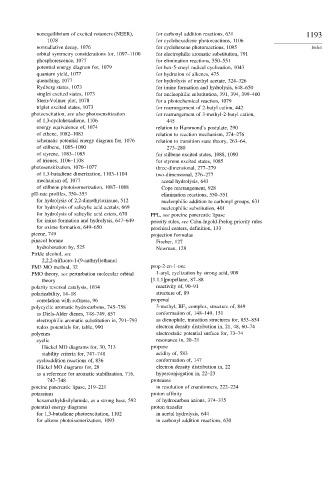Page 1206 - Advanced Organic Chemistry Part A - Structure and Mechanisms, 5th ed (2007) - Carey _ Sundberg
P. 1206
nonequilibrium of excited rotamers (NEER), for carbonyl addition reactions, 631 1193
1078 for cyclohexadiene photoreactions, 1106
nonradiative decay, 1076 for cyclohexene photoreactions, 1095 Index
orbital symmetry considerations for, 1097–1100 for electrophilic aromatic substitution, 791
phosphorescence, 1077 for elimination reactions, 550–551
potential energy diagram for, 1079 for hex-5-enoyl radical cyclization, 1043
quantum yield, 1077 for hydration of alkenes, 475
quenching, 1077 for hydrolysis of methyl acetate, 324–326
Rydberg states, 1073 for imine formation and hydrolysis, 648–650
singlet excited states, 1073 for nucleophilic substitution, 391, 394, 399–400
Stern-Volmer plot, 1078 for a photochemical reaction, 1079
triplet excited states, 1073 for rearrangement of 2-butyl cation, 442
photoexcitation, see also photosensitization for rearrangement of 3-methyl-2-butyl cation,
of 1,3-cyclohexadiene, 1106 445
energy equivalence of, 1074 relation to Hammond’s postulate, 290
of ethene, 1082–1083 relation to reaction mechanism, 274–276
schematic potential energy diagram for, 1076 relation to transition state theory, 263–64,
of stilbene, 1085–1090 273–280
of styrene, 1083–1085 for stilbene excited states, 1088, 1090
of trienes, 1106–1108 for styrene excited states, 1085
photosensitization, 1076–1077 three-dimensional, 277–279
of 1,3-butadiene dimerization, 1103–1104 two-dimensional, 276–277
mechanism of, 1077 acetal hydrolysis, 643
of stilbene photoisomerization, 1087–1088 Cope rearrangement, 928
pH-rate profiles, 350–353 elimination reactions, 550–551
for hydrolysis of 2,2-dimethyloxirane, 512 nucleophilic addition to carbonyl groups, 631
for hydrolysis of salicylic acid acetals, 669 nucleophilic substitution, 401
for hydrolysis of salicylic acid esters, 670 PPL, see porcine pancreatic lipase
for imine formation and hydrolysis, 647–649 priority rules, see Cahn-Ingold-Prelog priority rules
for oxime formation, 649–650 prochiral centers, definition, 133
picene, 749 projection formulas
pinacol borane Fischer, 127
hydroboration by, 525 Newman, 128
Pirkle alcohol, see
2,2,2-trifluoro-1-(9-anthryl)ethanol
PM3 MO method, 32 prop-2-en-1-one
PMO theory, see perturbation molecular orbital 1-aryl, cyclization by strong acid, 909
theory [1.1.1]propellane, 87–88
polarity reversal catalysis, 1034 reactivity of, 90–91
polarizability, 14–18 structure of, 89
correlation with softness, 96 propenal
polycyclic aromatic hydrocarbons, 745–758 3-methyl, BF 3 complex, structure of, 849
as Diels-Alder dienes, 748–749, 857 conformation of, 148–149, 151
electrophilic aromatic substitution in, 791–793 as dienophile, transition structures for, 853–854
redox potentials for, table, 990 electron density distribution in, 21, 48, 60–74
polyenes electrostatic potential surface for, 73–74
cyclic resonance in, 20–21
Hückel MO diagrams for, 30, 713 propene
stability criteria for, 747–748 acidity of, 583
cycloaddition reactions of, 836 conformation of, 147
Hückel MO diagrams for, 28 electron density distribution in, 22
as a reference for aromatic stabilization, 716, hyperconjugation in, 22–23
747–748 proteases
porcine pancreatic lipase, 219–221 in resolution of enantiomers, 222–224
potassium proton affinity
hexamethyldisilylamide, as a strong base, 592 of hydrocarbon anions, 374–375
potential energy diagrams proton transfer
for 1,3-butadiene photoexcitation, 1102 in acetal hydrolysis, 644
for alkene photoisomerization, 1093 in carbonyl addition reactions, 630

